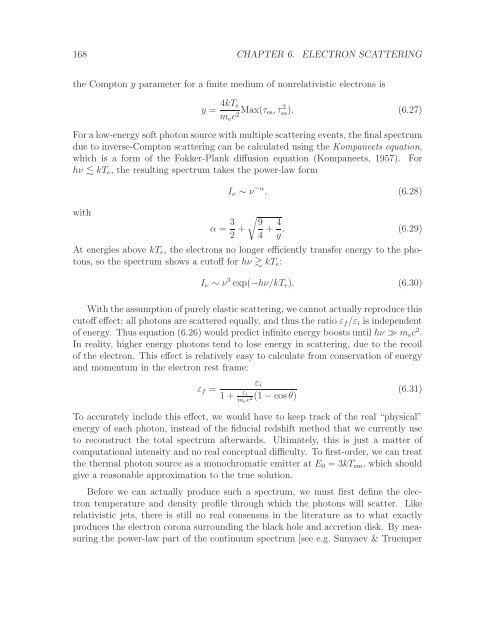Radiation Transport Around Kerr Black Holes Jeremy David ...
Radiation Transport Around Kerr Black Holes Jeremy David ...
Radiation Transport Around Kerr Black Holes Jeremy David ...
You also want an ePaper? Increase the reach of your titles
YUMPU automatically turns print PDFs into web optimized ePapers that Google loves.
168 CHAPTER 6. ELECTRON SCATTERING<br />
the Compton y parameter for a finite medium of nonrelativistic electrons is<br />
y = 4kT e<br />
m e c 2Max(τ es, τes 2 ). (6.27)<br />
For a low-energy soft photon source with multiple scattering events, the final spectrum<br />
due to inverse-Compton scattering can be calculated using the Kompaneets equation,<br />
which is a form of the Fokker-Plank diffusion equation (Kompaneets, 1957). For<br />
hν kT e , the resulting spectrum takes the power-law form<br />
I ν ∼ ν −α , (6.28)<br />
with<br />
α = 3 2 + √ 9<br />
4 + 4 y . (6.29)<br />
At energies above kT e , the electrons no longer efficiently transfer energy to the photons,<br />
so the spectrum shows a cutoff for hν kT e :<br />
I ν ∼ ν 3 exp(−hν/kT e ). (6.30)<br />
With the assumption of purely elastic scattering, we cannot actually reproduce this<br />
cutoff effect; all photons are scattered equally, and thus the ratio ε f /ε i is independent<br />
of energy. Thus equation (6.26) would predict infinite energy boosts until hν ≫ m e c 2 .<br />
In reality, higher energy photons tend to lose energy in scattering, due to the recoil<br />
of the electron. This effect is relatively easy to calculate from conservation of energy<br />
and momentum in the electron rest frame:<br />
ε f =<br />
ε i<br />
1 + ε i<br />
m ec 2 (1 − cosθ)<br />
(6.31)<br />
To accurately include this effect, we would have to keep track of the real “physical”<br />
energy of each photon, instead of the fiducial redshift method that we currently use<br />
to reconstruct the total spectrum afterwards. Ultimately, this is just a matter of<br />
computational intensity and no real conceptual difficulty. To first-order, we can treat<br />
the thermal photon source as a monochromatic emitter at E 0 = 3kT em , which should<br />
give a reasonable approximation to the true solution.<br />
Before we can actually produce such a spectrum, we must first define the electron<br />
temperature and density profile through which the photons will scatter. Like<br />
relativistic jets, there is still no real consensus in the literature as to what exactly<br />
produces the electron corona surrounding the black hole and accretion disk. By measuring<br />
the power-law part of the continuum spectrum [see e.g. Sunyaev & Truemper
















